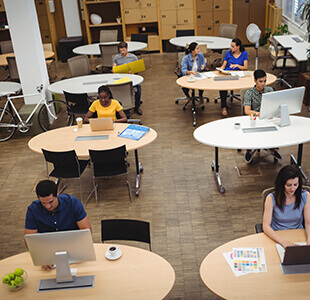The Evolution of Office Spaces: Post-Pandemic Trends and What They Mean for Investors
There are moments in history that act as pivot points, irrevocably changing the trajectory of societal norms. The pandemic, with its global reach and profound impacts, has undeniably been one of those moments. One of its lasting legacies is the transformation of workplaces. The once-familiar hum of office corridors, the rhythm of 9-to-5, has morphed, giving rise to new paradigms and design ethos. As we journey through this evolving landscape, let's uncover how these changes are shaping the investment horizons in commercial property.
The Dance of Hybrid Working
The once clear demarcation between home and office has now blurred. Organisations, having tasted the possibilities of remote work, are now embracing hybrid models—where employees split their time between homes, traditional offices, and alternative workspaces. This fluidity means a shift in demand. While the lure of expansive office buildings might wane, the appeal of flexible, adaptable spaces is on the rise.

Co-working Spaces: The New Kids on the Block
The co-working revolution, which began as a whisper, has now grown into a roar, further amplified by post-pandemic realities. These spaces, with their promise of flexibility, networking opportunities, and a break from home's confines, are increasingly becoming the choice for freelancers, startups, and even established firms. For investors, this signals a shift from traditional office spaces to more dynamic, communal, and shared environments.

Wellness at the Forefront
The pandemic, with its health implications, has brought the importance of wellness into sharp focus. Contemporary office designs now go beyond aesthetic appeal, integrating features that prioritise health and well-being. Think of spaces infused with natural light, biophilic designs that weave in nature, and layouts that promote physical distancing without compromising on collaboration. For investors, it's a call to reimagine and retrofit. Properties that align with this wellness narrative are likely to be more attractive in the post-pandemic world.

Decoding the Investment Implications
For the astute commercial property investor, these shifts paint a picture of opportunity and adaptation.
Location Dynamics: While city-centre skyscrapers were once the crowning jewels, the decentralisation of work might shift demand. Suburban properties, closer to residential hubs, or spaces that cater to satellite offices, could see increased interest.
Flexibility is King: Properties that offer adaptability – be it in terms of space configurations, lease terms, or usage – are likely to be more in demand. The ability to morph an office into a co-working space, a workshop hub, or even a hybrid model can be a distinct advantage.

Value Propositions: It's no longer just about square footage or swanky interiors. The value propositions of office spaces now lie in their ability to offer wellness features, tech integrations for seamless remote collaboration, and spaces that nurture community and creativity.
In the grand story of work and workplaces, the pandemic has penned a chapter that's transformative. It has prompted introspection, innovation, and a reimagining of what workspaces can and should be. For the commercial property investor, navigating this narrative requires both a grounding in current trends and a vision for the future. As the world of work evolves, may the investments made today resonate with the rhythms of tomorrow, promising both prosperity and relevance in the times to come.

